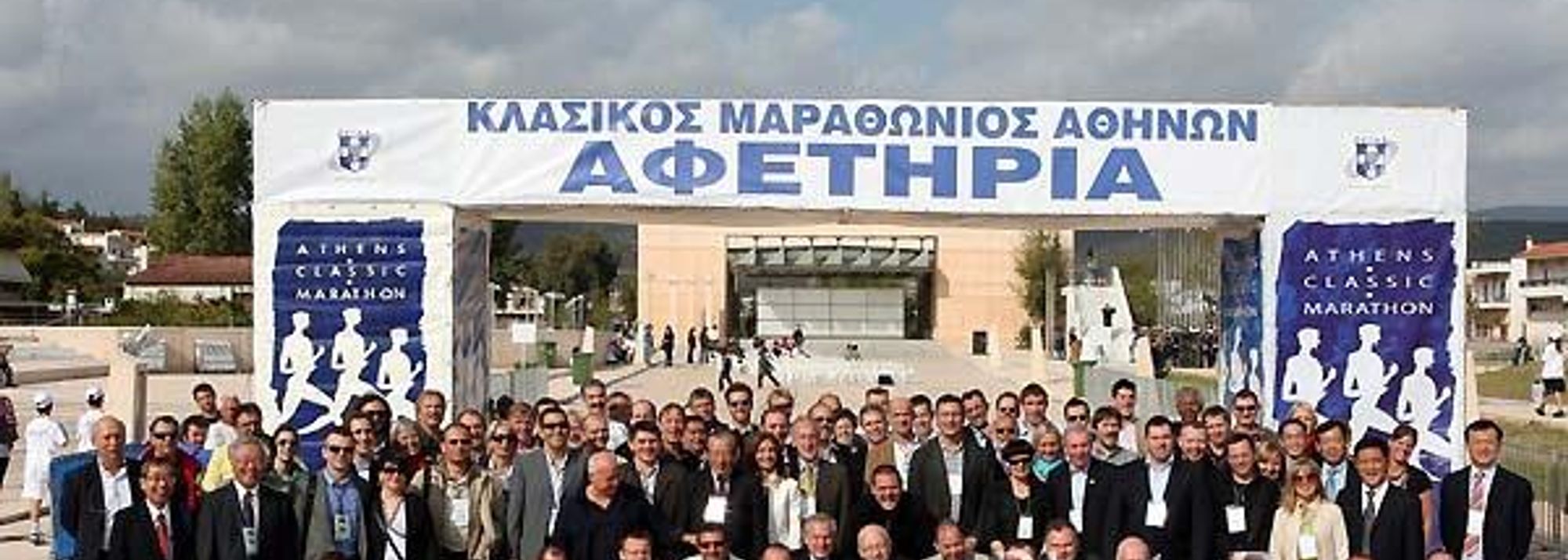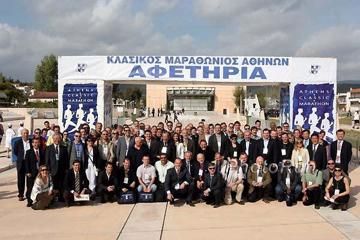Delegates at the 2nd AIMS Marathon Symposium (© Victah Sailer)
‘Adding value to your marathon’ was the topic of the 2nd Marathon Symposium of the Association of International Marathons and Road Races (AIMS) held in Marathon (Greece) on Saturday (9).
The Symposium took place on the day before the 26th Athens Classic Marathon which featured more than 10,000 runners (including running events at shorter distances) for the first time in its history. A large number of Race Directors from around the globe came to Marathon to participate in the Symposium.
While Berlin’s AIMS Executive Board Member Horst Milde and Kostas Panagopoulos of the Athens Classic Marathon were in charge as the chairmen of the Symposium the event was supported by the Mayor of the city of Marathon, Spiridon Zagaris, as well as the Greek Athletics Federation SEGAS and the International Association of Athletics Federations (IAAF). “This second Symposium was an even bigger success than the first one a year ago. Marathon simply makes the best venue for such an event since there is so much history here and we had a number of events taking place that symbolized just this,” said Milde.
The Athens Classic Marathon traditionally leads from Marathon to Athens. It was there where the story of the classic race began back in 1896. And of course the idea of the marathon origins from the legend of Pheidipidis, who is said to have run the distance from the battlefield near Marathon to Athens to announce the Greek victory against the Persians in 490 BC.
So in two years time there will be a very significant date for marathon running: It will be exactly 2,500 years since the origin of the marathon race. The year 2010 was already a major topic in Athens and Marathon this past weekend.
“As you all know we approach to the year 2010 which will be a landmark in the history of the classical marathon race since it will be 2,500 years after the Battle of Marathon, the cause for this race to be born,” said Hiroaki Chosa the President of AIMS from Japan. “The Athens Marathon is unique because of its history – it is the marathon,” said Horst Milde, who strongly believes that this is potentially one of the greatest races on earth. “In 2010 it will be the race everyone will want to run. It will be the race of the century.”
While the Athens Classic Marathon has its unique position because of the history other race organisers who attended the AIMS Symposium were encouraged by speakers to work out aspects of their races that are either unique or very characteristic.
“If we carry a race on Eurosport for two or three hours our commentators need good topics to talk about,” said Patrick Maitrot, the Director of Marketing and Partnerships of Eurosport. He said it is not enough to show the leading group alone. An attractive city or a special venue are important factors and a big field helps as well – all this makes additional stories to the ones provided by the elite field. Maitrot said that marathons are also getting more and more popular among companies regarding advertisements – during the TV coverage and also if there is online coverage.
But as international journalists Bob Ramsak and Pat Butcher stressed race organisers have to provide a good media service to make the most of their events.
“You have to have an experienced PR person who can make race information and statistics available before, during and after the race,” said Bob Ramsak. While it is obvious that national and international media interest is closely connected to an appropriate elite field Pat Butcher suggested to try to go for something unusual to create additional stories. “For example the Dresdner Kleinwort Frankfurt Marathon this year signed the former Steeplechase World record holder Bernard Barmasai. That made a good story internationally before the race. It is one idea to invite former superstars.”
The participants of the AIMS Symposium all went to the Marathon Tomb, the battlefield in 490 BC. This was the venue for a ceremony and a show by actors who symbolized the marathon race with all its strains.
“As the marathon spirit grows and expands throughout the world I feel that humanity should pay tribute to Greece, Marathon and Athens for their symbolism and historic value as the birth place of the ancient Olympic Games, which were later revived in modern times in this same country,” stated Chosa.
Together with Maria Polizou (Greek marathon record holder with 2:33:40) Hiroaki Chosa was later to light the ‘Marathon Fire’, which was brought to the starting point of Sunday’s race by a torch relay. Children covered the distance of about five kilometres from the Marathon Tomb to Marathon.
Additionally at the starting point of the Athens Classic Marathon a stone was unveiled, which was found at the former starting point of the Olympic Marathon in 1896. It carries the figure 40, which marks the distance of 40 kilometres the marathon runners had to cover at the first Olympics.
Finally there was another ceremony at the Marathon Museum in Marathon. Representatives of the city of Xiamen (China), where a big annual marathon takes place, unveiled two statues showing marathon runners. Much to the delight of Marathon’s mayor Spiridon Zagaris, Xiamen donated these to the Marathon Museum.
Jörg Wenig for the IAAF




